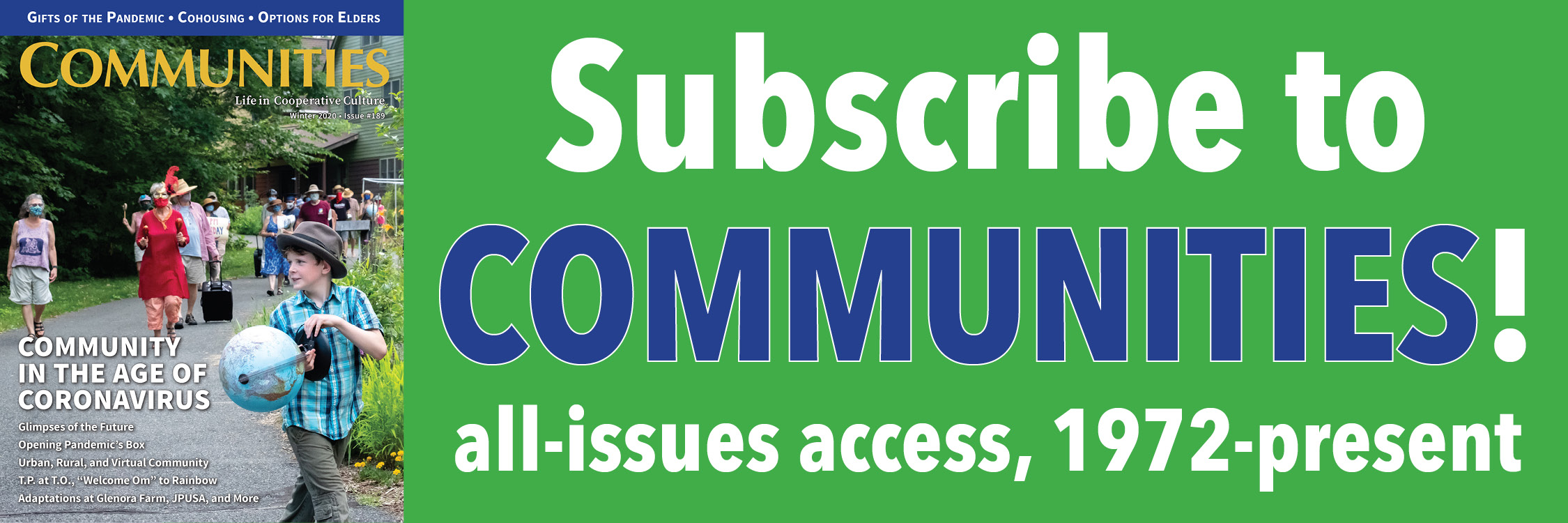Author: Hilary Giovale
Published in Communities Magazine Issue #142
We used to be a typical neighborhood. People were friendly enough and we waved to each other on our way into and out of our houses. We had the occasional chat on the sidewalk while shoveling snow or doing yard work. But that was where community ended on our block of West Birch Avenue in Flagstaff, Arizona. Our shady, tree-lined, historic downtown neighborhood mirrored countless neighborhoods across the United States: polite, but disconnected.
Knowing how valuable a connected neighborhood is, I had always wanted to create more meaningful neighborhood relationships than just small talk on the sidewalk. For one reason or another it never happened until one day when our neighborhood started a process that enabled us to connect in real ways. It began when my husband Pete and I consulted with a permaculture landscape company that was creating a design for our backyard. When they suggested we get chickens to eat our food scraps, make fertilizer, and provide eggs, I dismissed it immediately, thinking that chickens were far too ambitious for us as a single family with a five-year-old, a baby, and two cats. We had our plates full already.
I mentioned the landscape plan to our neighbor Jessie and suddenly a concept began to germinate: we could create a neighborhood chicken co-op! The idea had brilliant energy and momentum. The project gelled during a neighborhood potluck hosted at our house. We talked with more neighbors (Mark, who is also Pete’s brother; his partner Jamie; Jessie’s partner Brin; Sara; and Eric). We realized that we had five households of people on our block who were excited about the project. As we sat at our dining room table we discussed our collective ignorance about chickens, our fears about being able to care for them effectively, and our concerns that they would be noisy and smelly.
Despite these obstacles, Jessie decided to join because, in her words, “it was an opportunity to regain a relationship with the food we eat, and in the process a deeper connection to the natural world and our neighbors.” Sara was dubious but decided to go along with it because we were proposing housing the chickens in her backyard and she didn’t want to stand in the way of the project. For Pete and me, it was an opportunity to give our kids an experience that would highlight our values of sustainable local foods and community. By the end of the potluck, we were all committed.
It took shape quickly. One of the best things about the project was how each neighbor applied his or her unique skills. Jessie was the only one of us who had any experience with chickens, so she volunteered to keep the tiny chicks in her kitchen for their first couple weeks of life. She spearheaded the task of checking the chicks’ vents several times each day to ward off pasty butt and keep them healthy. Our daughter Gemma and Eric’s daughter Ellie were enamored with the chicks and Jessie left her back door unlocked during the day so the kids could visit them.
Eric had a friend with chickens, so he kindly arranged for us to borrow supplies we would need, like a large tub to house the chicks as they grew. At this stage, the chicks moved to our garage, where Pete used an old door from our basement and some chicken wire to rig up a “roof” to the tub so the chicks would be safe from our cats. Everyone in the neighborhood had the code to open the garage so they could visit the chicks during the day. I loved seeing how effortlessly the boundaries of private space began to open as the neighbors united in this common endeavor.
Mark owns the duplex where Jessie, Brin, and Sara are tenants, and he suggested that we use the old horse barn behind the duplex house for a coop. Pete and Mark developed a design for the coop that would keep our chickens warm in winter, cool in summer, and safe from foxes, skunks, and raccoons. Again, Pete harvested old windows and building supplies from our basement to create the coop. We were all so excited when we located some paint that was being given away free by the city to paint the inside of the coop.
The chicks grew rapidly and Pete, Mark, Eric, and Brin worked diligently on the construction of the coop. When it was time to put netting over the chicken run to protect them from predators, Jamie and Sara helped watch our baby Angus while other neighbors put up the netting. Gemma helped construct and paint a hot pink ramp for the chickens to go in and out. Meanwhile, I hosted another neighborhood potluck so we could enjoy our success and “talk chickens.” Eric organized a chicken rotation and each household now cares for the chickens a week at a time. Of course, if anyone ever needs someone to cover their shift, help is easy to find.
In this project, we have gained much more than fertilizer and eggs. We now have a shared commitment to these little beings that brings us together in satisfying ways. The chicken coop has become a sort of neighborhood commons where impromptu gatherings occur as neighbors stop by to drop off their kitchen scraps, give the birds fresh water, or brainstorm about how to fix a hole in the fence. It’s a great conversation piece when friends and relatives come to visit; we have been able to meet more of each other’s extended networks around the coop. The chickens also make us laugh as we watch them peck over old pieces of lettuce, moldy grapes, and pizza crusts.
Pete and Mark both put gates in their fences so we now have a corridor that runs across the back of three houses, linking us together. I like to see how this has increased our daughter’s sense of freedom within the neighborhood. She is now free to run back and forth between the yards and I don’t worry about her being alone in the front of the house by the street. Sometimes when Eric brings his daughter over (they live across the street) I’ll find that the girls have struck up a spontaneous playtime that may focus around the chickens or extend into our house. It has also increased Gemma’s ability to have independent relationships with the adults in our neighborhood. I’m glad that our children have this really cool project to do together and with other adults that enables them to feel freer in the world.
Taking care of these birds has created a shared sense of compassion and responsibility. Sara and I have both been surprised at how much we have come to like the chickens in the process of caring for them. One night, a ringtail cat got into the chickens’ yard and frightened one bird literally to death. Several of us heard the “ladies” squawking at 5:00 in the morning and Mark came to their rescue. During that day, I noticed how we all shared concern for our birds’ safety as we pieced together the details of what happened. Gemma took extra care with the chickens, visiting them often and making them “soup” of weeds and water that she hand-carried to them to help them recover from the scary event.
Another surprise along the way is how easy it was to create a miniature model of sustainable food production in an urban area. Jessie says, “the chicken co-op has helped me to realize that it’s not hard to build community or affect our food system. There isn’t any special formula or checklist to follow. A simple potluck is all it takes to bring people together to make a positive change.”
I love how this project is also teaching us and our children about the cycles of nature in a tangible way. Daily, we see our kitchen scraps devoured and transformed into poop for our gardens. We are just now starting to get an egg or two each day. For those of us who eat meat, we’ve had the opportunity to connect to that particular source of food in a real way.
In our neighborhood, we are allowed to have only hens and not roosters due to a city ordinance. So when we discovered that two of our original 16 chickens were roosters, we decided to slaughter and butcher them. This decision was something most of us felt squeamish about—a testament to how disconnected we are from the meat we eat. Most of us did not feel up to the task, but Pete and Eric volunteered and went through the process together from start to finish. Afterward, Pete and I cooked the roosters into broth and stew meat, which is in our freezer. The kids (who were not as squeamish as the adults) later saw pictures and heard the details of how it all happened, creating an important link for them in understanding where meat comes from, and seeing how their care and nurturing can contribute to the food we eat.
The next neighborhood potluck is due in a couple weeks, and we will be enjoying chicken soup à la West Birch Avenue, and perhaps a quiche or an omelet, homestyle.




















